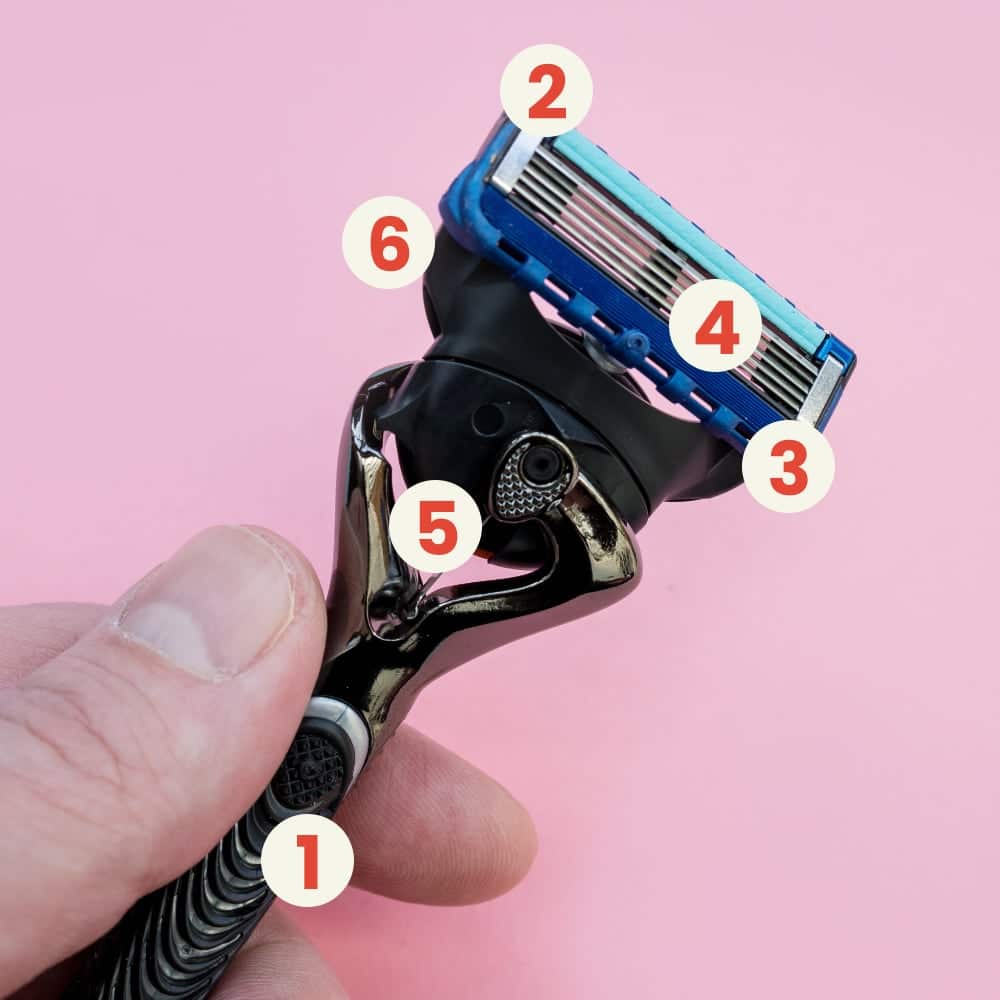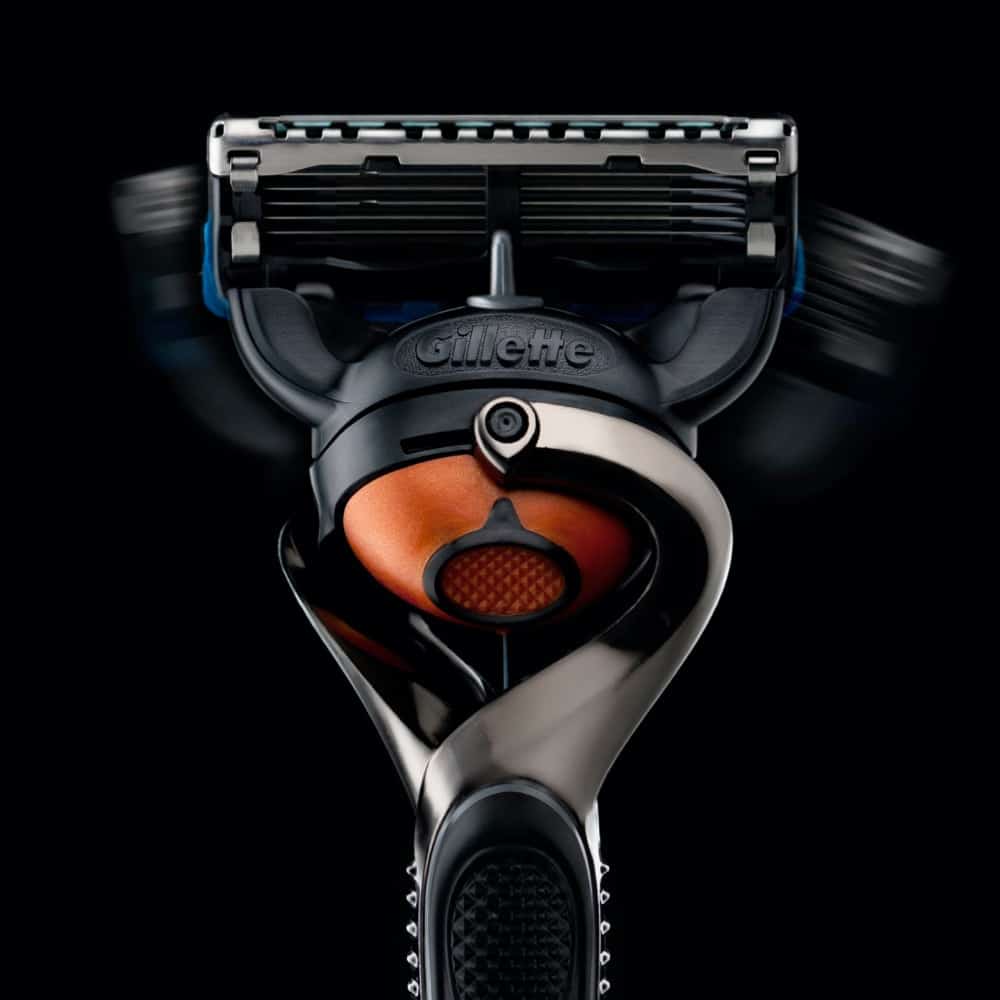Introduced in 1970 by Wilkinson, the cartridge razor has been the de-facto standard for shaving for the past 50 years.
With interchangeable heads, cartridge razors offer speed, convenience, and safety.
We’ll look at all the components of a cartridge razor and how they work together to give you a close, comfortable shave.
In this Article
| Topic | Key Points |
|---|---|
| Parts of a cartridge razor | A cartridge razor consists of a handle, lubricating strip, skin guard/guard bar, blade, ejector, and cartridge. |
| Does the number of blades matter? | More blades can displace the amount of pressure on the skin, leading to a more comfortable shave, but can result in ingrown hairs and mild irritation for some individuals. |
| Traveling-friendly | Cartridge razors are allowed in carry-on luggage when traveling. |
| Environmental impact | They are often made of plastic and contribute to landfill waste, but some companies offer recycling programs. |
| Learning to shave | Beginner-friendly and can be used with many types of shaving cream. |
| What can you shave? | Cartridge razors can be used to remove hair from just about any part of the body and have a pivoting head for easier use on curves. |
| Why are razor cartridges so expensive? | The construction of the blades and the need for companies to make a profit contribute to the high cost of razor cartridges. |
Parts of a cartridge razor
To explain what a cartridge razor is, we’ll need to look at the parts that make it up. Here is a diagram that we put together that labels all the major components of a cartridge razor:

Here’s what each of those parts does:
- Handle: Companies will often add a rubber or textured grip to make the razor easier to hold, even when hands are wet or coated in slick shaving cream.
- Lubricating Strip: The contents of this strip will vary from brand to brand and even from cartridge to cartridge. The lubricating strip is designed to help reduce irritation by coating the skin immediately after it is shaved. Companies often add glycerin, aloe vera, or Vitamin E to help soothe the skin.
- Skin Guard/Guard Bar: This is a series of small horizontal, often rubber, ridges that help to flatten and smooth the skin before it comes into contact with the blade.
- Blades: The blade is, of course, the part that is responsible for cutting the hair. Blades are nearly always made from stainless steel. The number of blades varies based on brand and model. Important to note here is that blades are set at a 30-degree angle for optimal performance.
- Ejector: On the neck of the cartridge, companies may add a small button that will eject the cartridge from the razor. Use this button to change the blade when it becomes dull.
- Cartridge: The entire head that contains the blade and other components are called the cartridge. Modern brands have proprietary fittings, so you must use their cartridges with their razors.
Does the number of blades matter?
Cartridge razors may have anywhere between 1 and 7 blades. The number of blades impacts two core components of the shave: comfort and aggressiveness of the shave.
More blades help to displace the amount of pressure that each one applies to the skin. A razor with a greater number of blades may feel more comfortable when shaving.
Conversely, more blades often result in the hair being cut closer to the skin. In fact, cartridge razors exhibit the hysteresis phenomenon, also known as lift-and-cut. Each blade works in tandem with one other, with the first cutting the hair and lifting it up slightly, then each subsequent blade cuts the hair at a slightly lower angle. This results in a closer shave.
Where this may become a problem for some men is that the hair may be cut too low, which could result in ingrown hairs (razor bumps) and mild irritation. Men with coarse or curly hair may be more prone to this issue and are recommended to use a cartridge razor with fewer blades or a specially designed razor like the Gillette SkinGuard.
Traveling-friendly
Per the TSA, cartridge razors are permissible in carry-on luggage making them a travel-friendly option when compared to other shaving tools like the safety razor or straight razor.
Environmental impact
While cartridge razors are more environmentally friendly than a disposable razors, they are still made from plastic that eventually makes its way into landfills. In fact, the Environmental Protection Agency once estimated in 1990 that 2 billion razors were thrown away each year. That number has likely increased since then.
However, to combat this, some companies have started recycling programs for their razors. For example, Gillette has partnered with TerraCycle to recycle their razors.
Learning to shave
Many folks learn to shave using a cartridge razor because the learning curve is relatively low. When you shave, you apply no to little pressure to the skin and glide the razor over the skin. When shaving with a cartridge razor, going with the grain or direction of hair growth is important. Shaving against the grain with a cartridge razor will worsen irritation, dryness, and ingrown hairs.
Also to note, cartridge razors can be used with many types of shaving cream and shaving gels.
What can you shave?

When compared to other shaving tools, cartridge razors remain the most versatile. Both men and women can use them to remove hair from just about any part of the body, including the face, legs, groin, arms, head, and underarms.
Unlike other types of razors, cartridge razors don’t require you to hold the razor at a specific angle while shaving – making it easier to shave hard-to-reach areas or shave around curves.
To make this easy, most cartridge razors have a pivoting head that allows the blade to move with the contours of your face. Some higher-end models can also tilt side-to-side to help you shave around curves.
Why are razor cartridges so expensive?

The reason that razor cartridges are so expensive is twofold. Unlike double-edge razor blades that are made from a single piece of metal, a cartridge razor blade is made from a series of small blades that are welded together and set in a plastic housing. This takes more time and effort to produce, which is why they are more expensive. The second reason is that razor companies need to make a profit, and refills are their way of doing so.
In most instances, companies will sell the razor handle at a loss just to get you in the door.
Luckily, there have been some newer entrants within the industry over the past few years that have helped to tame the cost of cartridge razors.
The Washington Post had an interesting story about this very topic as well.
Who makes them?
While Schick and Gillette remain the two largest manufacturers of cartridge razors, there are a number of other brands that have entered the market in recent years. Here are some of the most popular brands:
- Gillette
- Edgewell Personal Care (Schick, Wilkinson Sword, Harry’s)
- Dorco
- Bic
Compared to other shaving tools
Curious about how cartridge razors compare to a few other shaving tools? Here’s what you need to know:
- Safety Razors: Cartridge razors offer greater convenience, speed, safety, and versatility than safety razors. The biggest downside to cartridge razors is the higher lifetime costs, environmental impact, and susceptibility to ingrown hairs and irritation.
- Straight Razors: These are almost too different to compare. Cartridge razors are designed for speed and safety, while straight razors are more for the art of shaving. Straight razors will last a lifetime but require a lot of skill and practice to use properly.
- Electric Razors: A cartridge razor provides smoother results and is more versatile. Electric razors are fairly quick, don’t require shaving cream, and are travel-friendly.
- Disposable Razors: Cartridge razors perform better and will feel more comfortable. Disposable razors are cheap and convenient, but they are not as safe, often cause irritation, and are harmful to the environment.
I’ve been trying to market a cartridge razor which is shaped to allow easier multidirectional shaving. I’ve run into great difficulty getting razor companies to work with me on this. I also tried to produce a similar razor to be used with a double edge razor blade, as you seem to advocate with your wet shaving technique. My problem there, I just can’t seem to get a close enough shave with a traditional double edge blade. Having said that, I’ve discussed this with my barbers and others who love wet shaving. So, I may be missing something. If you can shed any light on any of this, I’d appreciate it.
Respectfully,
Ray